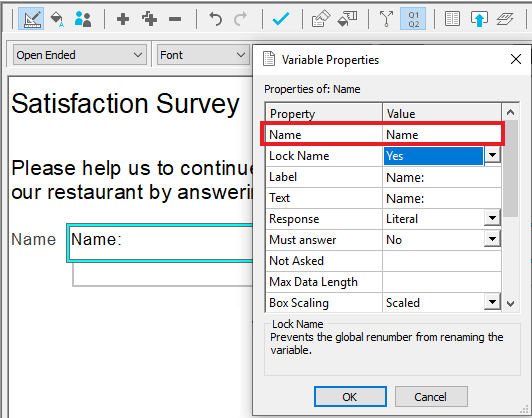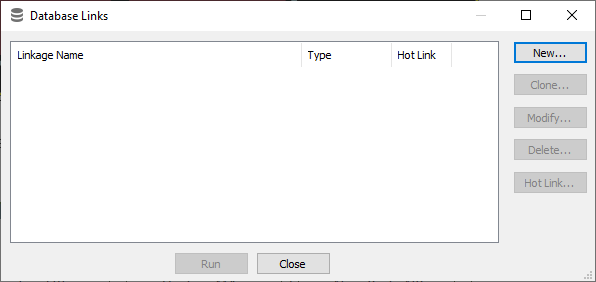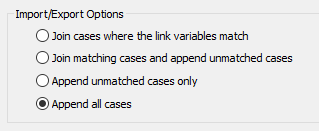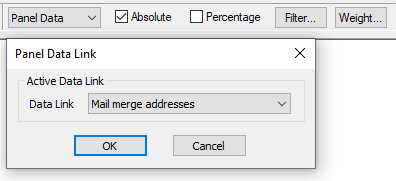Setting up mail merge
If you are producing a printed questionnaire for known respondents, you can insert the respondents’ names and addresses on the front page of the questionnaire, and then mail them directly. You need to have a database set up with the names and addresses of respondents beforehand. Each address line must be in a different field.
Once the respondents have completed and returned the questionnaire, their relevant details can then be keyed into Snap XMP Desktop. Subsequently, cases can be matched with records from the external database for the import of other personal information.
To set up the questionnaire for a mail merge you must:
- Create open-ended questions for the name and address lines.
- Create a new style for these questions so it places them in the correct position on the page.
- Create a link to the database holding your respondents’ names and addresses
- Select the link in Panel data in Data Entry mode and print the questionnaire
Adding the space for the respondent’s name
- Open the survey in Design mode and create a new Open Ended question below the subtitle.
- Type “Name:” in the area marked “Click here for text”. This is only used for reference while creating the style.
- Click
 or press Alt+Enter to open the Variable Properties dialog.
or press Alt+Enter to open the Variable Properties dialog.

- Change the question Name property to “Name” and click OK. The word “Name” now appears in place of the question number.
Set the style to position the space for the respondent’s name
- Select the Name question you have just created.
- Move the code box to the right of the question by selecting Positions in the toolbar topic list. Set the question Position to Beside.

- Select Columns from the drop-down list and set it to Full Page. Set the number of columns to 1, if it is set differently.

- Select Tabs in the toolbar topics, and then select Text in the drop-down list. Set the tab value to 0%. The space for the question text disappears, but that is fine, as it will be hidden. (The tab value sets the space reserved for text. You can move the response box to the right by increasing this value.)

- Select Alignment in the toolbar topics and then select Code Box and Left in the drop down lists.
- Use Ctrl++ to expand the response box until it is large enough for your address lines.
- Select Show from the toolbar topics drop-down list and uncheck the boxes for Name and Text.
- With Show selected, select Space before in the drop-down list, and set the Gap to 0.01cm. This specifies the gap between the lines of the address. You may need to set this to 0, or hide this space completely.
- Select Margins in the toolbar topics, and then select Data in the drop-down list. Set all the margin values to 0. This specifies the space between the box and the response data.

- Click
 or press Ctrl+M to go to Style mode.
or press Ctrl+M to go to Style mode. - Click
 to go to the Style Organiser. The style you have been working on will be selected in the left pane.
to go to the Style Organiser. The style you have been working on will be selected in the left pane. - Click
 and type “Address line” in the Name field then click OK. This creates a new style called “Address line”, containing your changes.
and type “Address line” in the Name field then click OK. This creates a new style called “Address line”, containing your changes. - Click OK to close the Style organiser. Click
 or type Ctrl+M to go back to Design mode.
or type Ctrl+M to go back to Design mode.
Create the address in your new style
- Select the Name question that you have just inserted. Look at the Style box. If your new Address line style is not selected, select it to apply it to the Name question.
- Press Enter to create a new question. It is automatically created in Address Line style.
- Click the Properties button
 and change the question Name property to “Address_1” and click OK.
and change the question Name property to “Address_1” and click OK. - Repeat to create variables for the maximum number of address lines stored in your database. The example shows Address_1, Address_2, Town, Post_zip_code. Note that no spaces can be used in variable names.
- Change to Style mode (press Ctrl+M or click
 ) and remove the boxes from the Address line style. While they make it easy to locate the variables in the questionnaire, they do not improve the look of the printed address.
) and remove the boxes from the Address line style. While they make it easy to locate the variables in the questionnaire, they do not improve the look of the printed address. - Select Boxes in the toolbar topics, and then select <None> in the drop-down list. The questionnaire now appears to have a blank area where the address variables are.
- Click
 to save your changes.
to save your changes.
Connect to your database of names and addresses
- Select File | Database Link to display the Database Linkage dialog and click New.

- The Database Linkage Wizard dialog is displayed. Select the Import from database option and click Next>.
- Click Select Database File and browse to the file containing the respondent data. (If the file is of an unrecognised type, you can identify it to Snap using the Build Data Link… button.)
- Select the table to use and click Next>. (If you do not wish to import details for all the respondents in the file, you can set a filter here.)
- The dialog displays a list of Import/Export Options. Select Append all cases. This option imports new cases from the database and appends them to the existing cases in the database. If you already have cases in your survey, you could select a different option so identical cases were not imported.

- The next dialog allows you to map the fields in the database to the fields in the questionnaire. Select the Snap field in the right-hand column that the data will be imported into until you have set up the name and address fields. Click Next>.

- A summary of your database link will be displayed. Change the name of the link to Mail merge addresses and click Finish.
- Click Close to close the Database linkage window.
Printing the questionnaires with the name and address information
- Change to Data View mode by clicking
 on the questionnaire window toolbar, or pressing Ctrl + Shift + D.
on the questionnaire window toolbar, or pressing Ctrl + Shift + D. - Select Panel Data (to show the people you have just added from the database) from the dropdown list. Select the Mail merge addresses database link.

- Click OK to display the questionnaire with the panel data included.
- Click the Print preview button
 .
.
- If you are happy with your questionnaire, select the All Filtered Cases radio button and click Print.
- If you need to make any changes select Cancel from the Print dialog. Change to Style mode and make any adjustments needed to the Address line style. (Changes you make to the style in Style mode will apply to all uses of that style) Then return to Data view mode to print.
You must print from Data View mode to include the imported panel data. If you print or publish from anywhere else, you will simply print out the empty questionnaire.
If you are printing a questionnaire for scanning, you must print the code boxes. Select Tailor| Questionnaire Design to open the Questionnaire Design Tailoring dialog. Clear the Hide boxes with data option. The box outlines will then be shown on the printed sheet.